Abstract
The stability performance of smart grid power systems is critical and requires special attention. Additionally, the combination of Battery Energy Storage (BES) systems, Solar Photovoltaic (SPV), and wind systems in the intelligent grid model provides utilities with excellent efficiency and dependability. However, a coordination grid with PV and other resources frequently results in severe issues, such as outages or power disruptions. A power outage in the grid might result in a power loss in the delivery system. As a result, the distributed grid model’s dependable performance is intended for integrated wind energy, SPV arrays, and BE systems. This paper proposes a renewable intelligent grid model to sustain solar power generation. The model incorporates a boost converter to optimize the performance of solar panels by converting the DC power generated by the panels into AC power for use in the grid. The boost converter is optimized using a novel Horse Herd Optimization Algorithm (HOA) method. In this case, the HOA method is used to optimize the control parameters of the boost converter, such as the duty cycle and the inductor and capacitor values. According to the final results, the proposed method has reduced the Total Harmonic Deformation (THD) and power loss. Additionally, the proposed method outperformed existing strategies related to the Expected Energy Not Supplied (EENS), Loss of Load Probability (LOLP), and Loss of Load Expected (LOLE), indicating the sustainability of power generation.
1. Introduction
The economic and environmental anxieties related to the use of fossil energy, as well as the realization that market forces alone are unlikely to move the necessary transitions in energy, have prompted some governments to implement Renewable Energy Policies (REP) []. Recently, Renewable Energy Sources (RESs) have been widely developed, leading to an increase in process performance. Along with these improvements, power network users’ proclivity to employ renewable energy has grown, resulting in RES adoption in energy systems globally for economic-environmental reasons []. Renewable energy has attracted the interest of numerous scholars and practitioners []. According to the International Energy Agency (IEA), renewable energy capacity grows on a yearly basis, escorted by dropping costs and increased investment. For example, the electricity-generating ability of RESs had its highest yearly increase in 2017, with over 178 GW added globally, increasing the overall capacity by nearly 9% from 2016 []. One of the primary barriers to converting fossil fuels to sustainability is their variable and incalculable character, which hinders their linking to energy networks []. Wind and solar photovoltaic (PV) are predicted to account for a substantial proportion of built renewable energy capacity []. Because of their insecurity, renewable energy sources have become a recurring issue. Microgrids, however, are seen as a workaround for efficiently maintaining renewable energy output. They may even be able to minimize the delivery of pollutants and cut expenses with the use of power storage and optimization techniques []. Business models for renewable power will be pushed as viable businesses, giving a boost to electricity businesses and independent electricity producers, as well as turning the farming sector into rural energy companies []. The Photovoltaic Supply Chain (PVSC) includes all operations linked to the conversion of energy and material flows through raw resources to the recovery or waste of energy stations via manufacturers, solar system assemblers, marketers, and final users or clients [].
Furthermore, Renewable Energy Technologies (RETs) are viewed as more technically and economically dependent in the rural areas of developing nations. Furthermore, because of the dispersed and distinct population, off-grid electricity is seen as an economical choice for gaining ingress on power in developing nations []. To fulfill this demand for multidimensional insights, SESAME (Sustainable Energy System Analysis Modelling Environment), a flexible technology capable of combining system-level and pathway-level Life Cycle Assessment (LCA), has been created []. In addition to solving the technical hurdles of intermittent RET, such as wind or PV, the coupling of RETs with power storage might be appealing from a techno-economic standpoint []. Some researchers have focused on the structural capacities underlying the public adoption of renewable energy because the primary factors include economic incentives, efficient legislation, and support programs []. In comparison, several studies suggest that RE has little effect on power output or carbon release absorption []. Effective global governance is critical to accelerating the rising proportion of renewables, organizing knowledge exchange and technological investments, and giving international help to underdeveloped nations []. From this vantage point, renewable power financing is also critical, since it is likely to be sufficient in both developed and developing countries by improving market globalization via the potential role of Foreign Direct Investment (FDI) and domestic investment inflows while enhancing renewable power sources []. The deployment of renewable energy sources in smart grids has produced various advantages and disadvantages that, if handled appropriately, may benefit both generation and consumption []. When renewables are used as hybrids, optimum sizing studies can be performed based on variable loads.
As a consequence, numerous approaches have been presented by researchers, such as Adaptive Sparrow Search Optimization [], fuzzy Boolean logic and Analytical Hierarchy Process (AHP) [], and IoT-based Artificial Intelligence [], to improve the efficacy, stability, and price of entry. Grid-based solutions have recently been significantly developed to continuously boost the manufacture of renewable sources and contribute to the health of energy grid systems. In any case, several difficulties of the grid system include power imbalance, voltage and reserve management, system stability, start-up cost, and security. These constraints must be overcome in order to create an efficient system. To resolve these problems, no effective solutions have emerged. As a result, a new methodology is used in this research.
The novelty of the HOA in renewable energy systems stems from its ability to optimize complex systems with multiple parameters and constraints while adapting to changing conditions. By simulating the behavior of horses in a herd, HOA can explore a wide range of solutions and find optimal solutions that would be difficult to obtain with other optimization algorithms. A renewable smart grid model to sustain solar power generation is not new. The idea of generating electricity from renewable energy sources such as solar power has existed for many years. The use of the HOA algorithm to optimize the performance of such a system, on the other hand, is a relatively new approach. While renewable energy and smart grid systems are not new concepts, using HOA to optimize the performance of a renewable intelligent grid model for solar power generation is a novel approach that can potentially improve the system’s efficiency and effectiveness.
We evaluated the performance of our algorithm using simulation models and compared it to that of other commonly used algorithms. The results demonstrate that our proposed algorithm outperforms the existing algorithms in terms of energy efficiency and grid stability.
The innovation of this study lies in the development of a novel smart grid model that is specifically designed to sustain solar power generation, and ultimately support the integration of more renewable energy sources into the power grid. This paper presents case studies in the results section of the proposed smart grid model in real-world settings, which can provide valuable insights into its feasibility and potential benefits.
2. Related Works
Imran et al. [] proposed a Hybrid Genetic Particle Swarm Optimization with a Heuristic-Based Programmable Energy Management Controller (HGPO-HPEMC (HHPEMC)). Consumers use solar panels to generate energy from microgrids—the energy used in residential buildings to cut power costs and carbon emissions. Users use solar panels to generate electricity from microgrids. The advantage is fewer variables to tune, and the disadvantages are high-dimensional space, falling into a local optimum is simple, and the iterative process has a low convergence rate.
One of the significant issues in power systems is the scheduling of energy resources. Hai et al. [] proposed a day-ahead scheduling paradigm; the “Hybrid Whale Optimisation Algorithm and Pattern Search (HWOA-PS)” optimization algorithm can solve the previous day-ahead scheduling problem, while both renewable and nonrenewable generating units can be used. The advantages are low environmental impact and low operating costs, and the disadvantage is that they tend to complicate even simple projects.
Renewable energy sources have received a lot of attention in recent years. Azad et al. [] developed a Grey Wolf Optimization (GWO) algorithm and the Sine–Cosine Algorithm (SCA), validating its efficiency in simultaneously supplying electrical and thermal demands in a stand-alone hybrid system that uses entirely renewable resources. The advantages are a solid global optimization capability and simple implementation, and the disadvantages are low solving accuracy and a slow convergence rate.
Energy storage systems, such as battery energy storage, have helped power grids accept intermittent renewable energy generation. Worighi et al. [] proposed a Micro-Grid Key Elements Model (MKEM). The virtualization of the proposed grid architecture addresses issues such as photovoltaic penetration, back-feeding, and supply irregularity. The advantages are micro-grids can reduce energy costs by utilizing locally generated energy, and they can be tailored to specific community needs. The disadvantage is that micro-grids are more complicated than centralized power systems.
Behera et al. [] proposed a Multi-Objective Improved Slime Mould Algorithm (MOISMA). This technique is expected to improve the performance of the micro-grid. However, using multiple renewable sources, such a quick-acting methodology reduces operating generation costs and emissions. These techniques can lower power generation costs and increase the energy resources used. The advantages are exploitation and exploration that are unbalanced, and the disadvantage is the simulation of foraging to solve the optimization problem.
The smart grid operation depends on the accurate predictions of electricity demand and Renewable Energy (RE) generation. Xia et al. [] introduced a novel method for predicting RE generation and electricity load using an improved stacked Gated Recurrent Unit Recurrent Neural Network (GRU-RNN); The modified GRU-RNN structure and improved training method enhance training efficiency and robustness. The advantage is that the recurrent neural network’s ability to remember is improved, and the disadvantages are its low learning efficiency and slow convergence.
The Peak-To-Average Ratio (PAR), bill cost, carbon emissions, and energy management issues can all be resolved by effectively integrating RES and Battery Storage Systems (BSS). Rehman et al. [] proposed a Load Scheduling and Energy Storage System Management Controller (LSEMC) based on heuristic algorithms; by incorporating low-cost RESs and the proposed power usage scheduling method, users’ electricity bills have been reduced. The advantages are the integration of demand response and renewable energy, and the disadvantage of the technique is increased maintenance needs. Table 1 displays the statistical analysis of the data and challenges of the existing work.

Table 1.
Challenges of the existing work.
The key contribution of the present research is outlined below:
- At first, the modelling of the SPV system, BE system, wind systems, as well as loads are integrated into the power grid designed by MATLAB.
- Hereafter, an AC and DC bus is connected to the inverter.
- A novel Horse Herd Optimized Algorithm (HOA) is proposed.
- The function of a convertor is improved using the novel HOA method, and the fitness is the horse’s herd behavior.
- Furthermore, the suggested method improved the grid model’s resiliency in relation to the LOLE, LOLP, and EENS.
- At last, a comparative analysis is carried out to validate the efficiency of our proposed methodology.
3. System Method along with Problem Description
The intelligent grid system includes measuring elements and a wireless-based technique for regulating the operation of electricity and improving the system stability through request control. The system described in this paper integrates wind power, a BES, an SPV, power converters, and non-linear loads. The grid-coupled combination of the RES system model is illustrated in Figure 1.
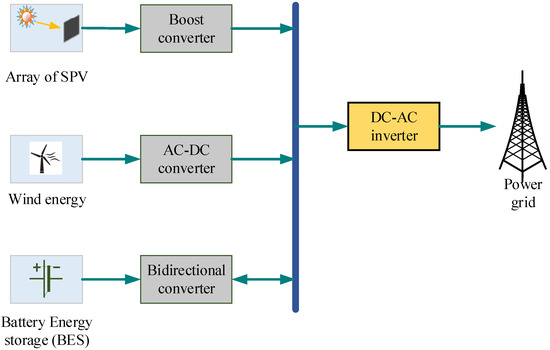
Figure 1.
Grid-coupled combination RES system model.
The incorporation of RES into the grid system allows elasticity in operation and two-way energy run to the grid method. However, failure and dependability issues in the grid inclusion method are possible. The integration of wind and SPV inputs varies according to solar irradiation and wind speed. Therefore it is crucial to implement an appropriately enhanced power-equalizing control mechanism to effectively regulate the output of the inverter.
4. Proposed Methodology
The planned grid system incorporates an array of SPV, a wind power system, loads, a BES, energy converters, and grid power. The energy generated by the wind turbines and SPV is deposited in the BE storage system. The generated energy is greater than the required load energy. In smart grid functioning, the BES offers a quick response and lowers power use costs. Figure 2 shows the proposed method of research.

Figure 2.
Proposed method.
To regulate the boost converter of the DC-to-DC converter, the proposed methodology uses the innovative HAO technique. It is used to solve problems involving continuous optimization.
4.1. Presented Boost Converter Control
The proposed HAO control method has been used to regulate the operation of the boost converter. This technique is based on the behavior of horses in their living place. The HOA control technology is integrated with a grid and an RES system to improve power network dependability. The control procedure is based on the error rate between the calculated and processed values. Variations in the solar radiation of the SPV and wind speed might have caused the mistake.
4.2. SPV System
Variations in illumination can directly impact the energy produced by the array of SPV. The energy from the SPV is increased by tilting the PV modules, and the illumination increases. Equation (1) [] calculates the energy produced by the SPV.
where, Sr(r) represents ideally slanted sunlight rays, Ao is the SPV array total surface area, and ωspv(r) represents the SPV array hourly proficiency.
4.3. Battery Energy System
The cell loses little power during charging or discharging, which is regarded as the self-discharge value. The level of the battery’s charge is calculated as the self-discharge value, which is represented using Equation (2) [].
where is denoted as the battery energy.
4.4. Wind Energy System
Wind power is calculated depending on the wind speed. Equation (3) [] expresses the relationship between wind power and speed.
where, Gb is the speed rating, Gn represents the cut-in speed of a wind generator, and GH denotes the reduction in the pace.
As a result, the predicted rate of the target performance is determined by the updated error value. The number of particles should be initialized initially for the objective function, which is assumed to be n, and arbitrarily put in a group. Equation (4) [] represents the initialization.
where, x = 1, 2, …; p and y = 1, 2, …; q, x, and y are groups of the number and a unique collection of scores inside a set; t is the random vector belonging to 0 and 1; Blow and Bhigh represent minimum and maximum duty cycle, respectively. The overall scores in the group are calculated using Equation (5) [].
As a result, the starting values of the error in the sets are determined by the aim achievement and randomly given in the first column of the duty cycle matrix, and it is considered the first function of all groups. Subsequently, the following column’s matrix of the duty cycle is arranged identically to the previous stage. This placement function is continued in instants. The duty cycle matrices are expressed using Equation (6) [].
Each row of represents each group of errors; consequently, the mistake of the first column of the duty cycle is the best of all. The duty cycle at the last point is regarded as the most difficult in the group. In an identical step size technique, the two vectors were used to evaluate the variations in each duty cycle in the set. The equal step size is calculated based on Equation (7) [].
where, denotes the ability to call a new duty cycle in the investigation region and refers to the capability of calling a close old duty cycle in a possible investigation region. The identical step size of and is calculated using Equations (8) and (9) [].
where, t1 and t2 denote the arbitrary vector that corresponds to 0 and 1, Bx,b and Bx,e are the group’s bad and excellent duty cycles in terms of goal results when compared to the total duty cycle value Bx,y. The duty cycle’s exploitative and exploring control is determined using Equations (10) and (11) [].
where, .
The ψ rate reduces, and λ improves while improving the rate of iteration . Consequently, the utilized value of the duty cycle is enhanced, while any undesired exploitation of the duty cycle is eliminated. Based on the calculated stage, the fresh duty cycle is assessed if the previous duty cycle range is not excellent. Using Equation (12) [], a new value is calculated.
After obtaining an excellent duty cycle, the excellent pulse is delivered to the boost converter, and the operation is halted until the next iteration begins.
4.5. Objectives
The system’s dependability is validated using the LOLE, LOLP, and EENS. According to the LOLE, the whole time taken for the integrated RES is insufficient to provide electricity to the critical load over a year, and the hours in one year are taken as 8760 h. The LOLE consistency index is computed using Equation (13) []
where, denotes the output current during the hours in which the integrated RES delivers electricity to the load. Furthermore, if loads are not executed, the result is measured as one; otherwise, the result is measured as zero. As a result, the LOLP is calculated by dividing the range of LOLE by the total number of hours worked in one year. Thus, Equation (14) [] expresses the relationship between LOLP and LOLE.
Therefore,
The EENS dependable rate is calculated, which states the amount of energy that is not given by the integrated RES during the course of the year, and it is expressed by Equation (15) [].
where, is the power of the load, and is the highest power created in hours.
Figure 3 shows the flow chart of the proposed HOA boost converter. The boost converter improves the step-up voltage to provide a DC bus. The HOA technique is initialized to the boost converter, and if processed, the arbitrarily used duty cycle matrix is evaluated using Equation (6). In addition, it generates the boost converter, calculates the error rate, and calculates the step size using Equation (7). If the computed value is maximum, a fresh duty cycle is assessed if the previous duty cycle range is not excellent. If the value is perfect, it controls the pulse of the boost converter switch. Finally, a significant result is obtained. Additionally, it solves the problems of the system’s effectiveness.

Figure 3.
Flow chart for the proposed HAO boost converter.
5. Results and Discussion
The proposed method is implemented on MATLAB R2018b restricted and a mathematical platform using an Intel (R) Core (TM) i5 CPU and 4 GB RAM. The specifications of the system technique are listed in Table 2 [].

Table 2.
Specifications of the system technique.
5.1. Case Study
The SPV performance is classified depending on the effects of the various irradiance phases. Figure 4 depicts the output curve of an array of SPV-based current versus voltage curves. The measurements are taken at various temperatures of the sunlight and each separate cell of the PV array.
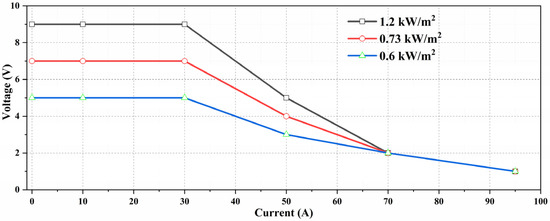
Figure 4.
An array of SPV under voltage with respect to a current curve.
As a result, the array of SPV energies with regard to the voltage factor at many solar temperatures is estimated for each cell. Figure 5 shows the energy behaviors related to the voltage. The observations show that each SPV cell achieved a current, voltage, and power rate of roughly 0.6 kW/m2, 0.73 kW/m2, and 1.2 kW/m2 under varying levels of solar irradiation.

Figure 5.
An array of SPV under voltage with respect to a power curve.
Figure 6 shows the array of SPV with a DC link voltage applied via the boost converter. It is the result of the inverter’s input value and the boost converter. In addition, the energy inverter’s input voltage is given as 250 V. Additionally, the electricity generated by the SPV is fed into the grid system. Figure 7 shows the power of the grid voltage and current. The estimated grid current and voltage are used to validate the output power.
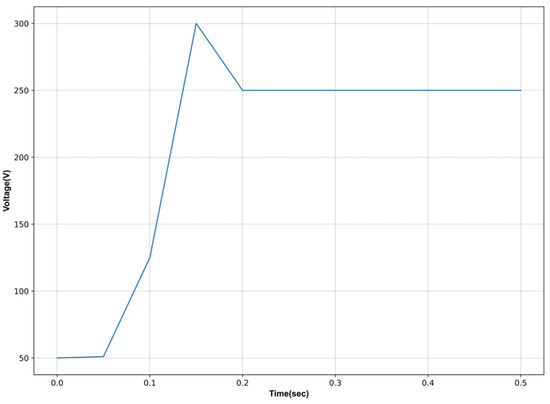
Figure 6.
SPV array with a DC link voltage applied to the boost converter.
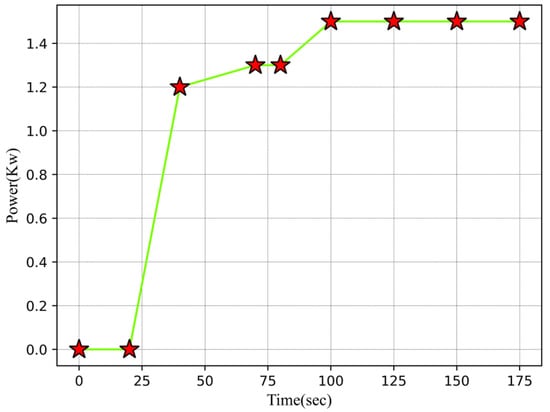
Figure 7.
Output power given to the power grid.
The power of a solar PV system over a year is calculated using hourly temperature and sun irradiation. Figure 8 demonstrates the solar irradiance as a function of time. In addition, the voltage of wind from the model is shown in Figure 9. The wind voltage ranges from 400 V to −400 V. However, the wind voltage ranges from −400 V to 400 V in a time span of 0 to 0.1 s.
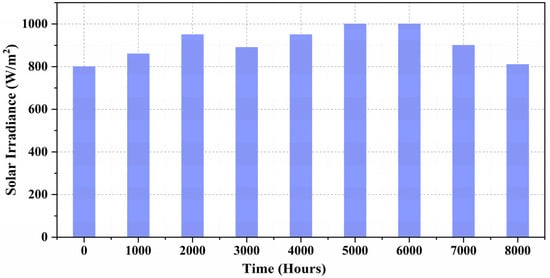
Figure 8.
The solar irradiance as a function of time.
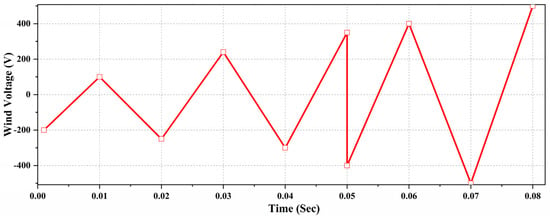
Figure 9.
Wind voltage of the model.
The grid-coupled inverter function is complex under grid current and voltage with low variation. Figure 10 shows the voltage process of the grid model. The obtained grid voltage denotes that there are no oscillations in the grid voltage and that the grid voltage waveform is sinusoidal.
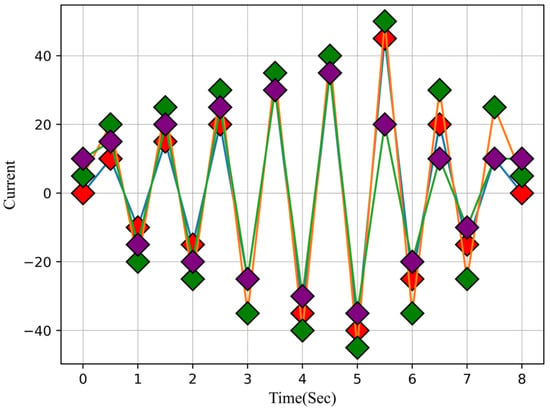
Figure 10.
Voltage process of the grid model.
Figure 11 shows the current grid function. According to Figure 11, a small fluctuation occurs when the proposed method is applied to the current waveform in the sinusoidal condition.
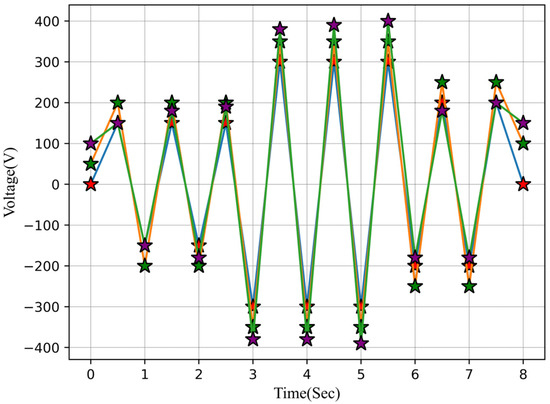
Figure 11.
The current process of the grid model.
Load variation can produce oscillations in the grid systems. Using the HOA model in a grid model reduces the voltage and current deformations in the grid model. As a result, the grid voltage in the form of sinusoidal and recent deforms at the start. Furthermore, the grid model’s THD is about 0.8%, and the method’s Energy Loss (EL) is about 0.05 MW. The THD of the grid current is shown in Figure 12.
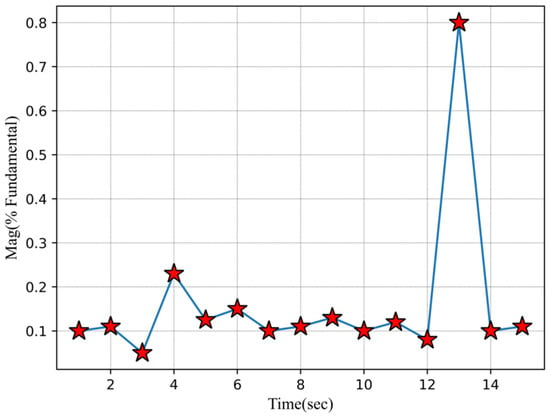
Figure 12.
Grid current of THD.
Table 3 shows the reliable performance of the proposed method before and after optimization. It verifies the consistent performance improvement achieved by using the suggested HAO approach. In Table 4, the trustworthy parameters under varied loads, such as 50% and 100% loads, are given. The suggested HAO model enhances the system’s sustainability and reliability functions for LOLP, LOLE, and EENS.

Table 3.
Reliability indices using the proposed model.

Table 4.
Reliability function under different load conditions.
5.2. Performance Estimation
The increased reliability function using the provided HAO methodology is compared to other techniques for LOLP, LOLE, and EENS and is reported in Table 5. EENS, LOLE, and LOLP have been confirmed for 70 MW wind and 70 MW solar with Hobbled Shepherd Optimization (HSO) for Multi-Objective Based Golden Eagle (MOGE) []; 80 MW wind and 80 MW SPV with Alternative Model Creating Technique (AMCT), Two Parameters Based Alpha Model Technique (TPBAMT) and the proposed Fuzzy Fault Tree Based Technique (HDFFTBT) []; 25 MW wind and 25 MW SPV with Roy Billinton Test System (RBTS) []; and 1.5 MW SPV + 1.5 MW wind with Harmony Search (HS) []. The proposed HOA approach outperforms other existing techniques in terms of characteristics (LOLP, LOLE, and EENS). The objective function is constructed during sizing studies, and mathematical calculations are performed to obtain the lowest value of this function []. The Internet of Things (IoT) is an integrated system of advanced technologies and solutions that connects devices, people, platforms, software, and solutions via the Internet []. Existing grids face challenges, such as security and privacy, reliability, diverse renewable energy sources, and rising energy consumption. A smart grid is the best solution to these problems [].

Table 5.
Comparison of methods.
The total findings demonstrate that the present HAO technique for the grid system has boosted the sustainability and dependability of the power-generating system.
5.2.1. LOLE
A comparison between the proposed HAO and the existing techniques in terms of LOLE is shown in Figure 13. The LOLE of our proposed horse herd optimization is 0.23 (MWh/year). At the same time, compared to other existing methods, the LOLE of the proposed HOA has a lower value. The existing method of HSO with MOGE is 0.314 (MWh/year) with 0.354 (MWh/year). The value it represents is greater than that of the proposed HOA method. Compared to the other existing techniques, AMCT and TBBAMT with HDFFTBT are 0.83 (MWh/year) and 0.89 (MWh/year) with 1.29 (MWh/year), which is high. When Comparing the values of HS and RBTS, our proposed method demonstrates a lower level of LOLE. Specifically, the LOLE of the proposed method is 0.23 (MWh/year), which is significantly lower than that of the HOA and other existing techniques.
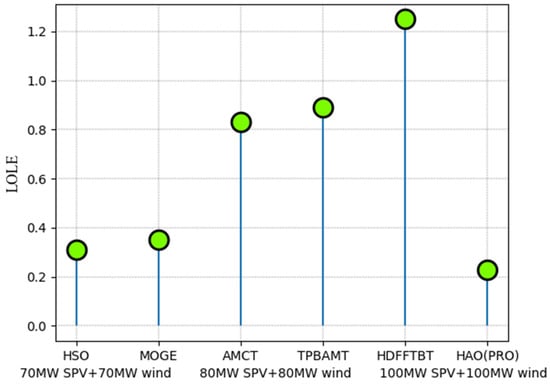
Figure 13.
Comparison of the existing and proposed techniques in terms of LOLE.
5.2.2. LOLP
A comparison between the proposed HAO and existing techniques in terms of LOLP is shown in Figure 14. The LOLP method of the proposed HOA has a lower value. The existing method of HSO with MOGE is 75.25% with 76.85%. It is a higher value than that of the proposed HOA method. Compared to other existing techniques, AMCT and TBBAMT with HDFFTBT are 70.38% and 72.18% with 68.43%, which is high. Comparing the HS and RBTS values, our proposed method shows a lower value of LOLP. The LOLP of HOA is 43%, which is low compared to other existing techniques.
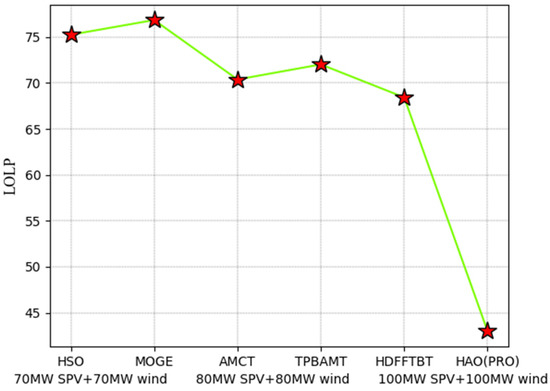
Figure 14.
Comparison of the existing and proposed techniques in terms of LOLP.
5.2.3. EENS
A comparison between the proposed HAO and the existing techniques in terms of EENS is shown in Figure 15. The EENS method of the proposed HAO has a lower value. The existing method of HSO with MOGE is 3 (103 MW) with 2.8 (103 MW). It is a higher value than that of the proposed HAO method. Compared to other existing techniques, AMCT and TBBAMT with HDFFTBT are 2.5 (103 MW) and 2.76 (103 MW) with 1.2 (103 MW), which is high. Comparing HS and RBTS values, our proposed method shows a lower value of EENS. The EENS of HOA is 0.2 (103 MW), which is a low value compared to other existing techniques.
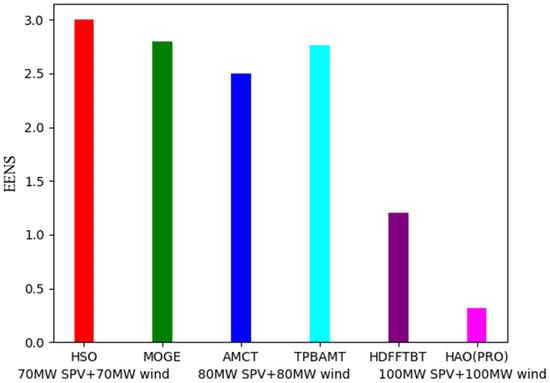
Figure 15.
Comparison of the existing and proposed techniques in terms of EENS.
6. Conclusions
A hybrid RES with a grid system is an important choice for an advanced power system. The use of fossil fuels is increasing due to the fast expansion of industry, vehicles, and population growth. They are harmful to both humans and the environment. However, fossil fuels play an important role in electricity generation. As a result, RES is a preferable alternative to fossil fuels since it is sustainable and renewable. Wind and solar PV are the most often used sources since they provide adequate power to the loads. Furthermore, the BE system is linked to the distributed grid systems in remote areas. The HOA method is a novel approach that has been shown to improve the function of boost converters in smart grid systems. By optimizing the converter parameters, the algorithm can improve the system’s efficiency and ensure that the power generated by the solar panels is fully utilized. The proposed method reduced THD and EL by 0.8% and 0.05 MW, respectively. Comparing parameters such as EENS, LOLP, and LOLE with other current models proves the system’s dependability, which can be improved by 68%, 35.82%, and 36.36 to an existing model. The parameters of the proposed model are robust and dependable. Machine learning or deep learning methods will be developed in future work to increase the system model’s sustainability and reliability.
Author Contributions
Conceptualization, methodology, software, validation, formal analysis, investigation, resources, data curation, writing—original draft preparation by M.A.B., writing—review and editing by M.A.B., visualization, supervision, project administration, funding acquisition done by I.A. All authors have read and agreed to the published version of the manuscript.
Funding
This research was supported by the Deanship of Scientific Research, Majmaah University, Al-Majmaah-11952, Kingdom of Saudi Arabia, under the project number: R-2023-355.
Data Availability Statement
The data analyzed in this study is in the paper.
Conflicts of Interest
The authors declare no conflict of interest.
References
- Pitelis, A.; Vasilakos, N.; Chalvatzis, K. Fostering innovation in renewable energy technologies: Choice of policy instruments and effectiveness. Renew. Energy 2020, 151, 1163–1172. [Google Scholar] [CrossRef]
- Rafinia, A.; Moshtagh, J.; Rezaei, N. Stochastic optimal robust design of a new multi-stage under-frequency load shedding system considering renewable energy sources. Int. J. Electr. Power Energy Syst. 2020, 118, 105735. [Google Scholar] [CrossRef]
- Rani, P.; Mishra, A.R.; Mardani, A.; Cavallaro, F.; Alrasheedi, M.; Alrashidi, A. A novel approach to extended fuzzy TOPSIS based on new divergence measures for renewable energy sources selection. J. Clean. Prod. 2020, 257, 120352. [Google Scholar] [CrossRef]
- Hannan, M.A.; Tan, S.Y.; Al-Shetwi, A.Q.; Jern, K.P.; Begum, R.A. Optimized controller for renewable energy sources integration into microgrid: Functions, constraints and suggestions. J. Clean. Prod. 2020, 256, 120419. [Google Scholar] [CrossRef]
- Alberizzi, J.C.; Frigola, J.M.; Rossi, M.; Renzi, M. Optimal sizing of a Hybrid Renewable Energy System: Importance of data selection with highly variable renewable energy sources. Energy Convers. Manag. 2020, 223, 113303. [Google Scholar] [CrossRef]
- Banacloche, S.; Herrera, I.; Lechón, Y. Towards energy transition in Tunisia: Sustainability assessment of a hybrid concentrated solar power and biomass plant. Sci. Total Environ. 2020, 744, 140729. [Google Scholar] [CrossRef]
- Chen, C.; Hu, Y.; Karuppiah, M.; Kumar, P.M. Artificial intelligence on economic evaluation of energy efficiency and renewable energy technologies. Sustain. Energy Technol. Assess. 2021, 47, 101358. [Google Scholar] [CrossRef]
- Ben Jebli, M.; Farhani, S.; Guesmi, K. Renewable energy, CO2 emissions and value added: Empirical evidence from countries with different income levels. Struct. Chang. Econ. Dyn. 2020, 53, 402–410. [Google Scholar] [CrossRef]
- Mastrocinque, E.; Ramírez, F.J.; Honrubia-Escribano, A.; Pham, D.T. An AHP-based multi-criteria model for sustainable supply chain development in the renewable energy sector. Expert Syst. Appl. 2020, 150, 113321. [Google Scholar] [CrossRef]
- Solangi, Y.A.; Longsheng, C.; Shah, S.A.A. Assessing and overcoming the renewable energy barriers for sustainable development in Pakistan: An integrated AHP and fuzzy TOPSIS approach. Renew. Energy 2021, 173, 209–222. [Google Scholar] [CrossRef]
- Gençer, E.; Torkamani, S.; Miller, I.; Wu, T.W.; O’Sullivan, F. Sustainable energy system analysis modeling environment: Analyzing life cycle emissions of the energy transition. Appl. Energy 2020, 277, 115550. [Google Scholar] [CrossRef]
- Morales-Mora, M.A.; Pijpers, J.J.; Antonio, A.C.; Soto, J.D.L.C.; Calderón, A.M.A. Life cycle assessment of a novel bipolar electrodialysis-based flow battery concept and its potential use to mitigate the intermittency of renewable energy generation. J. Energy Storage 2021, 35, 102339. [Google Scholar] [CrossRef]
- Irfan, M.; Hao, Y.; Ikram, M.; Wu, H.; Akram, R.; Rauf, A. Assessment of the public acceptance and utilization of renewable energy in Pakistan. Sustain. Prod. Consum. 2021, 27, 312–324. [Google Scholar] [CrossRef]
- Shan, S.; Genç, S.Y.; Kamran, H.W.; Dinca, G. Role of green technology innovation and renewable energy in carbon neutrality: A sustainable investigation from Turkey. J. Environ. Manag. 2021, 294, 113004. [Google Scholar] [CrossRef]
- Sanderink, L. Shattered frames in global energy governance: Exploring fragmented interpretations among renewable energy institutions. Energy Res. Soc. Sci. 2020, 61, 101355. [Google Scholar] [CrossRef]
- Gozgor, G.; Mahalik, M.K.; Demir, E.; Padhan, H. The impact of economic globalization on renewable energy in the OECD countries. Energy Policy 2020, 139, 111365. [Google Scholar] [CrossRef]
- Wei, L.; Yi, C.; Yun, J. Energy drive and management of smart grids with high penetration of renewable sources of wind unit and solar panel. Int. J. Electr. Power Energy Syst. 2021, 129, 106846. [Google Scholar] [CrossRef]
- Liu, B.; Rodriguez, D. Renewable energy systems optimization by a new multi-objective optimization technique: A residential building. J. Build. Eng. 2021, 35, 102094. [Google Scholar] [CrossRef]
- Noorollahi, Y.; Senani, A.G.; Fadaei, A.; Simaee, M.; Moltames, R. A framework for GIS-based site selection and technical potential evaluation of PV solar farm using Fuzzy-Boolean logic and AHP multi-criteria decision-making approach. Renew. Energy 2022, 186, 89–104. [Google Scholar] [CrossRef]
- Rajawat, A.S.; Mohammed, O.; Shaw, R.N.; Ghosh, A. Renewable energy system for industrial internet of things model using fusion-AI. In Applications of AI and IOT in Renewable Energy; Academic Press: Cambridge, MA, USA, 2022; pp. 107–128. [Google Scholar]
- Imran, A.; Hafeez, G.; Khan, I.; Usman, M.; Shafiq, Z.; Qazi, A.B.; Khalid, A.; Thoben, K.-D. Heuristic-based programable controller for efficient energy management under renewable energy sources and energy storage system in smart grid. IEEE Access 2020, 8, 139587–139608. [Google Scholar] [CrossRef]
- Hai, T.; Zhou, J.; Muranaka, K. Energy management and operational planning of renewable energy resources-based microgrid with energy saving. Electr. Power Syst. Res. 2023, 214, 108792. [Google Scholar] [CrossRef]
- Azad, A.; Shateri, H. Design and optimization of an entirely hybrid renewable energy system (WT/PV/BW/HS/TES/EVPL) to supply electrical and thermal loads with considering uncertainties in generation and consumption. Appl. Energy 2023, 336, 120782. [Google Scholar] [CrossRef]
- Worighi, I.; Maach, A.; Hafid, A.; Hegazy, O.; Van Mierlo, J. Integrating renewable energy in smart grid system: Architecture, virtualization and analysis. Sustain. Energy Grids Netw. 2019, 18, 100226. [Google Scholar] [CrossRef]
- Behera, S.; Choudhury, N.B.D. Adaptive Optimal Energy Management in Multi-Distributed Energy Resources by using Improved Slime Mould Algorithm with considering Demand Side Management. e-Prime-Adv. Electr. Eng. Electron. Energy 2023, 3, 100108. [Google Scholar] [CrossRef]
- Xia, M.; Shao, H.; Ma, X.; de Silva, C.W. A stacked GRU-RNN-based approach for predicting renewable energy and electricity load for smart grid operation. IEEE Trans. Ind. Inform. 2021, 17, 7050–7059. [Google Scholar] [CrossRef]
- Rehman, A.U.; Wadud, Z.; Elavarasan, R.M.; Hafeez, G.; Khan, I.; Shafiq, Z.; Alhelou, H.H. An optimal power usage scheduling in smart grid integrated with renewable energy sources for energy management. IEEE Access 2021, 9, 84619–84638. [Google Scholar] [CrossRef]
- Dawoud, S.M. Developing different hybrid renewable sources of residential loads as a reliable method to realize energy sustainability. Alex. Eng. J. 2021, 60, 2435–2445. [Google Scholar] [CrossRef]
- Eltamaly, A.M.; Alotaibi, M.A.; Alolah, A.I.; Ahmed, M.A. A novel demand response strategy for sizing of hybrid energy system with smart grid concepts. IEEE Access 2021, 9, 20277–20294. [Google Scholar] [CrossRef]
- Baseer, M.A.; Alsaduni, I.; Zubair, M. A novel multi-objective based reliability assessment in Saudi Arabian power system arrangement. IEEE Access 2021, 9, 97822–97833. [Google Scholar] [CrossRef]
- Akhtar, I.; Kirmani, S.; Jameel, M. Reliability assessment of power system considering the impact of renewable energy sources integration into grid with advanced intelligent strategies. IEEE Access 2021, 9, 32485–32497. [Google Scholar] [CrossRef]
- Yang, H.; Zhang, Y.; Ma, Y.; Zhou, M.; Yang, X. Reliability evaluation of power systems in the presence of energy storage system as demand management resource. Int. J. Electr. Power Energy Syst. 2019, 110, 1–10. [Google Scholar] [CrossRef]
- Memari, M.; Karimi, A.; Hashemi-Dezaki, H. Reliability evaluation of smart grid using various classic and metaheuristic clustering algorithms considering system uncertainties. Int. Trans. Electr. Energy Syst. 2021, 31, e12902. [Google Scholar] [CrossRef]
- Tabak, A.; Özkaymak, M.; Güneser, M.T.; Erkol, H.O. Optimization and evaluation of hybrid PV/WT/BM system in different initial costs and LPSP conditions. Int. J. Adv. Comput. Sci. Appl. 2017, 8, 123–131. [Google Scholar] [CrossRef]
- Khanh, Q.V.; Hoai, N.V.; Manh, L.D.; Le, A.N.; Jeon, G. Wireless communication technologies for IoT in 5G: Vision, applications, and challenges. Wirel. Commun. Mob. Comput. 2022, 2022, 3229294. [Google Scholar] [CrossRef]
- Minh, Q.N.; Nguyen, V.H.; Quy, V.K.; Ngoc, L.A.; Chehri, A.; Jeon, G. Edge Computing for IoT-Enabled Smart Grid: The Future of Energy. Energies 2022, 15, 6140. [Google Scholar] [CrossRef]
Disclaimer/Publisher’s Note: The statements, opinions and data contained in all publications are solely those of the individual author(s) and contributor(s) and not of MDPI and/or the editor(s). MDPI and/or the editor(s) disclaim responsibility for any injury to people or property resulting from any ideas, methods, instructions or products referred to in the content. |
© 2023 by the authors. Licensee MDPI, Basel, Switzerland. This article is an open access article distributed under the terms and conditions of the Creative Commons Attribution (CC BY) license (https://creativecommons.org/licenses/by/4.0/).